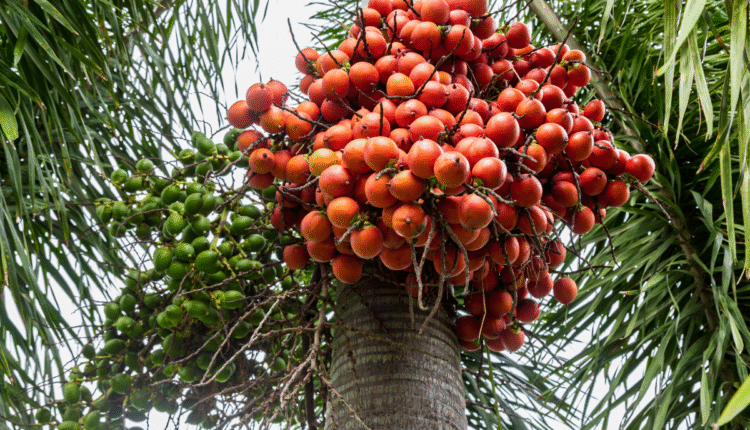Arecanut Cultivation: In our country, arecanut is used in paan or some people chew it just like that. Apart from this, arecanut is also used in religious events and worship. That is why India is not only the largest producer of arecanut, but also the largest consumer country. Here, most arecanut is cultivated in Karnataka, Kerala, Assam, Tamil Nadu, Meghalaya and West Bengal.
A temperature of 25 to 35 degrees is necessary for the cultivation of arecanut. If betelnut is grown as an intercrop, the income of farmers will double. Krishi Vigyan Kendra, Hirehalli told the farmers of Tumkur district about the advanced method and new technology of growing betelnut, which benefited the farmers a lot.
Betelnut is cultivated in large quantities in Tumkur
Betelnut is grown in about 34,719 hectares in Tumkur, but apart from many problems like falling of flowers, falling of fruits, bursting of fruits, the income of betelnut producers was also affected due to diseases and pests, because these cause a lot of damage to the crop. In such a situation, Krishi Vigyan Kendra, Hirehalli not only solved the problems of the farmers, but also suggested a way to increase the income.
Technique in Betelnut Cultivation
Long variety of betelnut seeds were given to the farmers. Apart from this, it was advised to apply borax at the rate of 30 grams per tree along with recommended farm yard manure and fertilizers. During the Rabi season, its intercropping with cowpea, dolichos, French bean and bottle gourd was also suggested. As per the need, advised to use insecticides and fungicides to protect against common pests and diseases. By adopting the advice given by Krishi Vigyan Kendra, there was a good increase in the yield and income of the farmers.
Benefits to farmers in betel nut cultivation
After the intervention of Krishi Vigyan Kendra, high quality Hirehalli variety was sown in 450 hectares of area. After this, the cases of falling of nuts reduced. The yaw decreased from 12 percent to 3.4 percent. In the demo field, 9.54 quintals of yield was obtained per hectare which was 12.5 percent more than the yield obtained by the farmers. 2600 farmers of the area adopted crop management techniques in 8000 hectares of land.
Income from Arecanut Farming
The Krishi Vigyan Kendra advised the farmers of Tumkur district to grow arecanut as an intercrop with cowpea, dolichos, French beans and bottle gourd and those who adopted this practice saw a significant increase in their income. Growing arecanut with French beans generated an additional income of Rs 50,000, while growing betelnut with cowpea generated an additional income of Rs 35,000.
The height of the arecanut tree goes up to 50-60 feet. Intercropping also improved the health of the soil as it increased the organic matter in the soil. Apart from this, the incidence of foot rot disease also reduced from 28 per cent to just 12 per cent. Before the intervention of the Krishi Vigyan Kendra, the farmers were earning Rs 1,60,000 per hectare and now it has increased to Rs 2,25,000 i.e. an additional income of Rs 65,000 per hectare.
Information on Arecanut Farming
The following steps can be followed to grow arecanut:
The arecanut is capable of growing in a wide range of soils. It grows best in well-drained soil. It is sensitive to lack of moisture and should be grown where adequate water is available.
Selection of land: Select suitable soil for arecanut cultivation. Keep the soil well-drained and water-efficient.
Selection of seeds: Select the best quality arecanut seeds. For betelnut cultivation, its plants are first prepared in the nursery. The seeds are sown in the beds. During sowing, keep in mind the proper distance and depth of the seeds.
Irrigation: Irrigate the arecanut plants regularly.
Fertilizer: Give proper fertilizer to the arecanut plants for growth. This may include fertilizer, compost, regular manure or special fertilizer.
Disease and pest management: Manage diseases and pests on arecanut plants. Water, fungicides, and pesticides can be used for this.
If you want to cultivate betel nut, it is important to take advice from local agricultural experts and keep in mind the demand of the local market. To double the income of farmers, things like proper management of farming, adoption of new technology, selection of good quality seeds, marketing support are very important.
Contact us- If farmers want to share any valuable information or experiences related to farming, they can connect with us via phone or whatsApp at 9599273766 or you can write to us at [email protected]. Through Kisan of India, we will convey your message to the people, because we believe that if the farmers are advanced then the country is happy.



